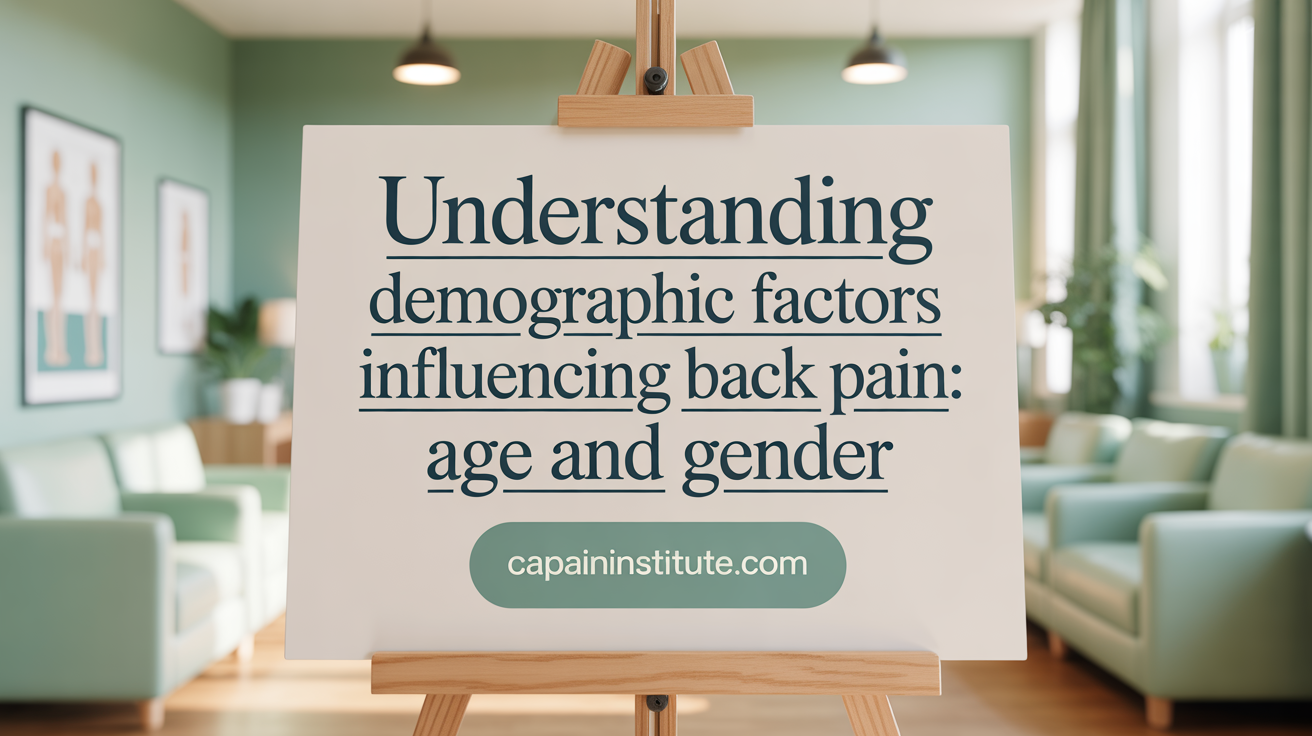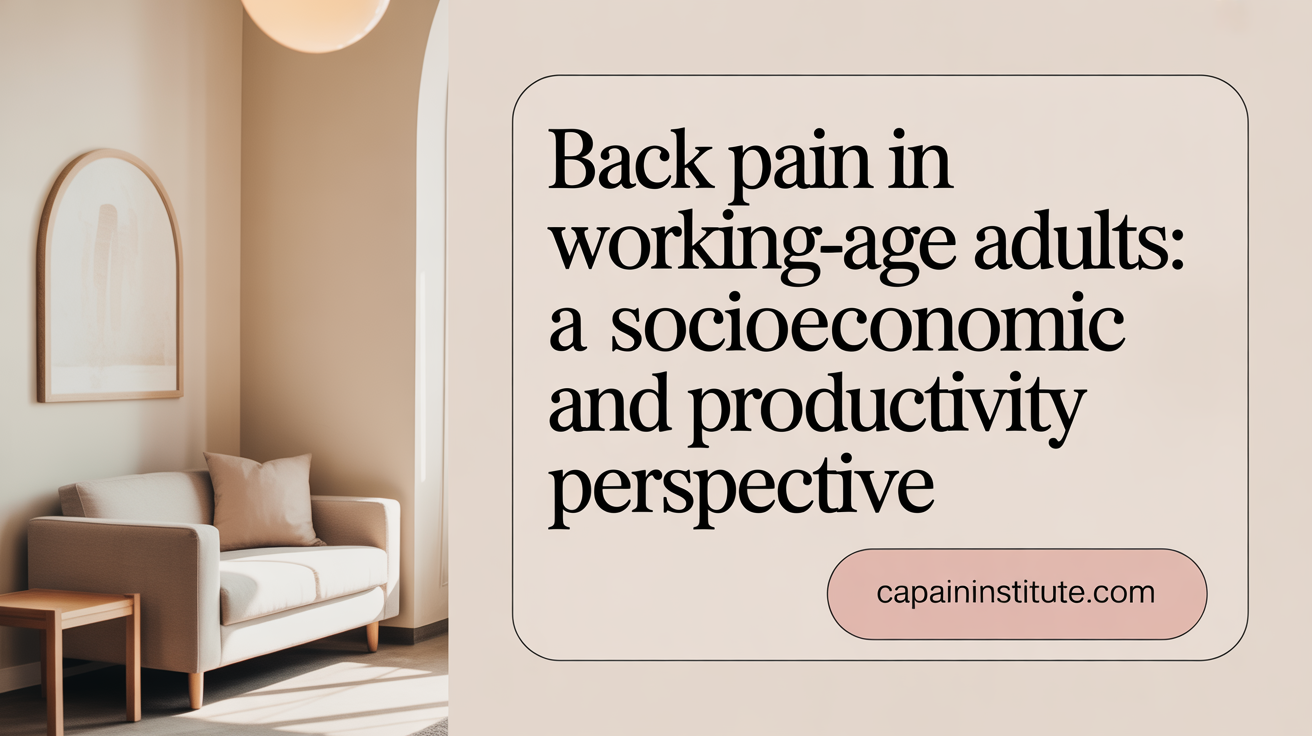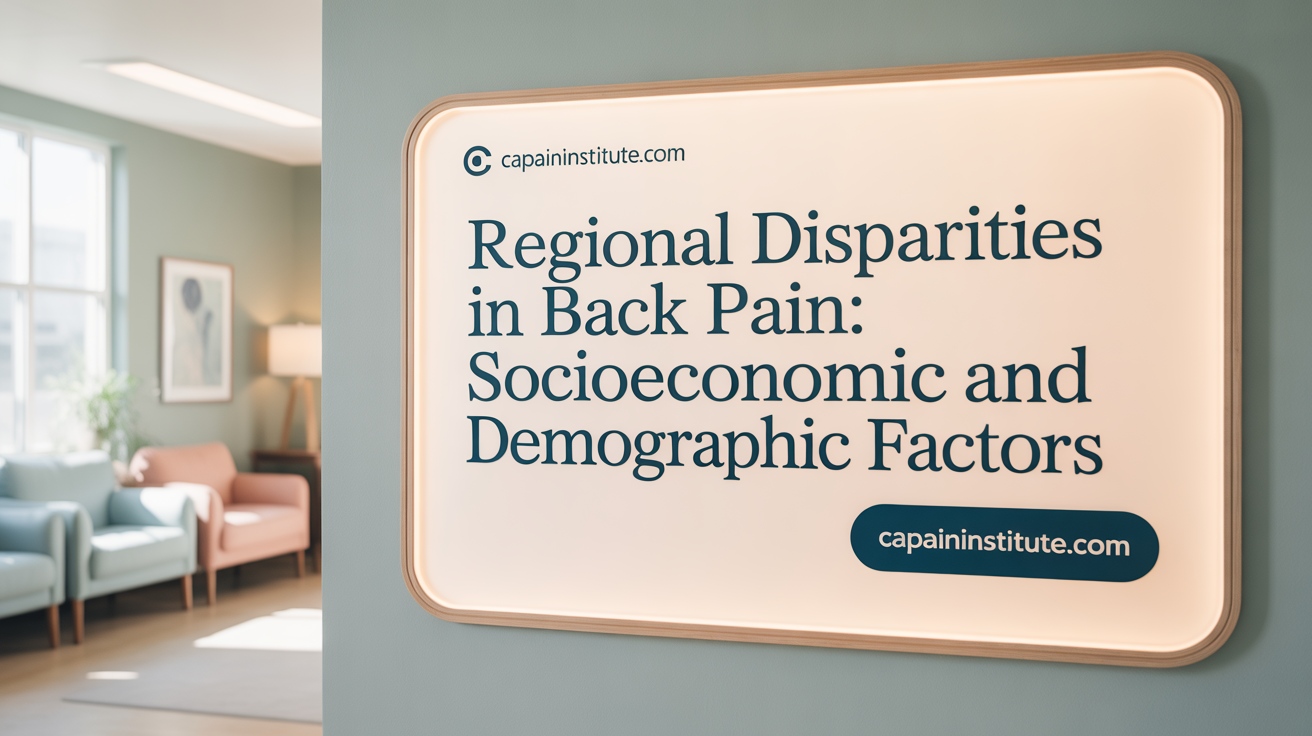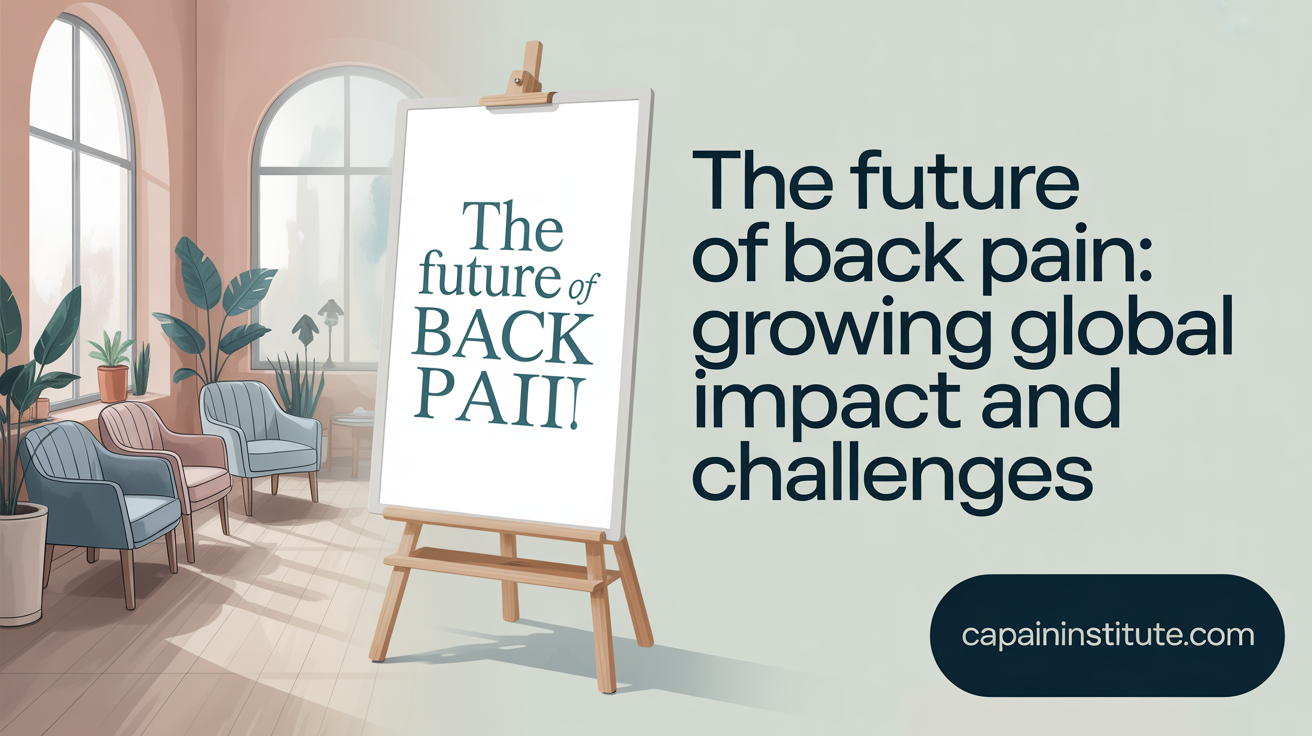Understanding the Widespread Burden of Back Pain
Back pain, especially low back pain (LBP), remains one of the most pervasive and disabling conditions worldwide. Affecting hundreds of millions, it transcends age, gender, and geographic boundaries. This article explores the global incidence and prevalence of back pain, demographic variations, influential factors, epidemiological trends, and the profound public health and economic consequences associated with this condition. By analyzing authoritative data and emerging patterns, we aim to illuminate the challenges posed by back pain and underscore the critical need for informed management and prevention strategies.
Global Incidence and Prevalence of Back Pain
What is the global incidence and prevalence of back pain?
Back pain, especially low back pain, is a widespread health concern affecting a significant portion of the global population. In 2020, over 619 million people worldwide experienced low back pain, a number expected to increase to about 843 million by 2050. This projected rise is mainly driven by population growth and aging trends.
Prevalence rates tend to increase with age, peaking around the ages of 50 to 55 years. The highest impact of back pain is seen among older adults, particularly those aged 80 to 85 years, where disability and prevalence are at their peak. Women generally report higher rates of back pain than men, especially in later years.
Despite a modest decrease of approximately 10% in the age-standardised prevalence and years lived with disability (YLDs) between 1990 and 2020, the overall burden remains significant. Back pain remains the leading cause of disability worldwide, accounting for about 7.7% of all YLDs in 2020.
Most cases are classified as non-specific back pain, meaning they lack a clear, identifiable anatomical cause. This form accounts for roughly 90% of cases, making diagnosis and management challenging. The wide prevalence of back pain underscores its importance as a global public health issue, affecting individuals of all ages, including children and adolescents.
How do prevalence rates vary across regions?
Prevalence rates differ notably across geographical regions. In 2020, the highest age-standardised prevalence rates were recorded in central Europe, with 12,800 cases per 100,000 people, followed by eastern Europe and Australasia. Regions with higher socioeconomic development tend to report higher incidence and prevalence, especially among the working-age population.
What does future projection look like?
Looking ahead, the burden of back pain is expected to increase further. By 2050, the number of cases is projected to surge due to ongoing demographic shifts. Most regions anticipate an increase of more than 25%, emphasizing the need for effective prevention and management strategies.
In summary, back pain is a prevalent, growing concern worldwide, impacting millions across all age groups. Its rising prevalence, particularly among older adults, and higher rates in women, call for targeted public health interventions to reduce its impact.
| Aspect | Data | Additional Details |
|---|---|---|
| 2020 global cases | 619 million | Estimated to rise to 843 million by 2050 |
| Highest prevalence region | Central Europe | 12,800 per 100,000 |
| Age group most affected | 50–55 years | Peak prevalence; |
| Gender differences | Women > Men | Higher rates among females, especially in older age |
| Trends (1990–2020) | ↓ 10% in prevalence rate | Despite this, case numbers are increasing due to population dynamics |
| Future projections | +25% cases by 2050 | Driven by aging and population growth |
| Main types of back pain | Non-specific (~90%) | Difficult to identify precise causes |
| Disability contribution | 7.7% of total YLDs | Leading global cause of disability |
This overview highlights the widespread impact of back pain globally, its variation across different demographics, and the importance of continued research and healthcare strategies.
Age and Gender: Key Demographic Drivers of Back Pain

Which demographic groups are most affected by back pain?
Back pain impacts various demographic groups, but older adults, especially those aged 65 and above, bear the highest burden. The prevalence increases with age, peaking around the age of 80, making this group particularly vulnerable.
Women are consistently more affected than men, experiencing higher rates of back pain, including chronic forms that significantly limit daily activities. This gender disparity is visible across all age brackets but tends to be more pronounced in older women.
Racial and socioeconomic factors also influence back pain prevalence. Non-Hispanic white adults report higher occurrences of back pain compared to other racial groups. Additionally, individuals with lower income levels, particularly those earning less than $20,000 annually, are more susceptible, highlighting a social component to risk.
Occupational status plays a role as well. Middle-aged adults engaged in blue-collar jobs often face higher exposure to risk factors like poor ergonomics, contributing to increased back problems.
Prevalence patterns suggest a continuous rise with age across all demographics, but the highest incidence and disability levels are observed among older populations. These findings emphasize the importance of targeted prevention and management strategies for vulnerable groups.
| Demographic Group | Prevalence & Impact | Additional Factors |
|---|---|---|
| Older Adults (65+) | Most affected, peak around 80 years of age | Increased disability, comorbidities |
| Women | Higher prevalence and severity | Hormonal, anatomical, and psychosocial factors |
| Racial Groups | Higher in non-Hispanic whites | Socioeconomic status influences access and risk |
| Income Level | Lower income correlates with higher prevalence | Limited access to healthcare and ergonomics |
| Occupational Exposure | Blue-collar workers at increased risk | Ergonomic hazards, physical labor |
Understanding these demographic differences helps in designing focused interventions and resource allocation to reduce back pain's global burden.
Modifiable and Non-Modifiable Factors Influencing Back Pain Occurrence
What factors influence the occurrence of back pain in different demographics?
Back pain is a complex condition influenced by a mix of biological, psychological, and social factors that vary across different groups. Age is a significant non-modifiable risk factor; prevalence tends to increase with age, peaking around 50 to 55 years and rising further in those aged 80 and above. Older adults often experience more disability from back pain, which is closely linked to degenerative changes in the spine.
Gender also plays a role, with women showing a higher prevalence of back pain than men. This might be due to hormonal differences, biomechanical factors, or societal roles that affect physical activity levels and stress. Women are also more likely to experience chronic back pain, adding to the overall burden.
Socioeconomic status influences back pain through various pathways. People with lower income and less education may have limited access to healthcare and resources for preventive care or management. Occupations involving physical labor or poor ergonomic conditions further increase risk. Regions with higher socioeconomic development often report higher prevalence rates, possibly because of greater awareness or reporting.
Lifestyle choices such as smoking, obesity, and physical inactivity significantly impact back pain risk. Smoking impairs blood flow to spinal structures, increasing susceptibility to degeneration. Excess weight puts additional strain on the spine, especially in the lower back. Conversely, regular exercise and maintaining a healthy weight can reduce the likelihood of developing back pain.
Psychological factors, including depression, anxiety, and pain catastrophizing, heighten the risk of chronic back pain. Individuals with mental health issues often experience heightened pain perception and may have poorer treatment outcomes.
Occupational factors are also critical. Jobs involving repetitive movements, heavy lifting, or poor ergonomics contribute to back strain. Workers in physically demanding roles and those involved in compensation or litigation processes tend to report higher back pain incidence.
Overall, back pain affects various demographics differently due to an interplay of age, gender, socioeconomic background, lifestyle, mental health, and occupational risks. Understanding these influences helps tailor prevention and management strategies to diverse populations.
Epidemiological Trends and Patterns Over Recent Decades

What are the epidemiological trends and patterns of back pain over time?
Recent data on back pain reveal a complex and evolving picture. Although the age-standardized rates for prevalence and years lived with disability (YLDs) have shown a slight decline over the last 30 years—around 10%—the total number of cases has risen sharply. This increase is mainly driven by the global population growth and aging demographics.
Globally, approximately 619 million people experienced low back pain in 2020, and projections indicate this number will climb to about 843 million by 2050. Despite the decline in rates, the sheer volume of cases continues to grow. This is especially true among older populations, with the highest prevalence occurring in those aged 50-55 years and peaking at around 85 years.
The pattern of back pain is also marked by its recurrent and chronic nature. Most individuals experience at least one episode in their lifetime, with about 8% of adults suffering from persistent or chronic pain. These chronic cases tend to account for a disproportionate amount of disability, even though fewer than a third of all individuals with back pain have significant restrictions for more than six months.
Regional differences are a notable aspect of epidemiological patterns. Some regions, such as central and eastern Europe and Australasia, report higher prevalence rates, with rates in high-income countries often exceeding those in lower-income regions. The burden is also higher among women, with prevalence rates approximately 60% greater than in men.
Modifiable risk factors have played a significant role in shaping these trends over time. Occupational ergonomic risks, smoking, and high BMI are major contributors, accounting for wide variability in burden across different populations and eras.
In summary, while technological and social advances have influenced back pain epidemiology, population growth and aging remain primary drivers of its rising prevalence and impact, highlighting the need for adaptive strategies in management and prevention.
Back Pain Among Working-Age Adults: A Socioeconomic Challenge

Which population segments are most impacted by back pain, particularly regarding working-age groups?
Back pain significantly affects the working-age population, with the highest prevalence occurring between ages 50 and 55. During these years, many individuals experience peak disability related to low back pain, which can diminish their ability to work effectively. Women within this age group experience higher rates of back pain than men, with evidence showing a widening gender disparity over recent years.
Globally, regions classified as middle socio-demographic index (SDI), including South Asia, China, and India, carry a disproportionate share of the burden. Although high SDI countries report higher incident cases and disability, middle SDI nations face considerable challenges due to limited healthcare resources and occupational exposures.
Occupational ergonomic risks are prominent contributors. Many workers encounter physical strain, repetitive movements, and poor workplace ergonomics, which elevate the risk of developing back pain. Psychosocial stressors, including job insecurity and high workload, along with unhealthy lifestyle factors like poor overall health and high BMI, further intensify the issue.
Despite measures that have led to modest declines in age-standardized rates over the last three decades—from 4,111 per 100,000 in 1990 to 3,676 per 100,000 in 2021—the total number of cases has increased from 126 million to nearly 193 million due to population growth and aging trends.
This rise translates into substantial socioeconomic impacts, such as reduced work productivity, increased healthcare utilization, and higher disability-related costs. Chronic back pain affects individuals' ability to remain employed, often resulting in lower incomes and decreased quality of life.
| Aspect | Data | Explanation |
|---|---|---|
| Prevalence peak | Age 50–55 | Most affected ages in working adults |
| Female rates | Higher than males | Women experience higher incidence and disability |
| Regional burden | Middle SDI countries | Higher overall impact, resource challenges |
| Occupational risks | Ergonomic factors | Repetitive movements, poor workplace setup |
| Economic impact | $12 billion annually | Costs from healthcare and lost productivity |
| Trends | Rising absolute cases | Despite declining standardized rates |
Addressing back pain in working-age adults requires targeted interventions that focus on ergonomic improvements, psychological support, and health promotion programs to reduce both individual suffering and broader economic consequences.
Public Health Impact: Disability and Years Lived with Disability (YLD)
What is the public health impact of back pain according to statistical data?
Low back pain (LBP) stands as a significant global health challenge. In 2020, it affected approximately 619 million people around the world, and projections suggest this number could reach over 843 million by 2050, driven by population growth and aging populations.
LBP is the leading cause of disability worldwide, accounting for a substantial portion of years lived with disability (YLDs). In 2020, it was responsible for about 7.7% of all YLDs globally, highlighting its extensive impact on individuals’ daily functioning and societal productivity.
The burden of LBP disproportionately affects older adults, with the highest disability impact observed in those aged 80–85 years. Women are also more affected than men, with higher prevalence rates and greater disability contributions. Chronic back pain, which persists for five years or more in many cases, impacts millions of adults, especially in countries like the United States, where around 8% of adults report persistent symptoms.
This condition not only hampers quality of life but also drives high healthcare utilization and costs. Adults with back pain tend to visit healthcare providers more frequently, use more medications, and experience greater limitations in social, recreational, and work activities. The economic consequence includes over $12 billion annually in healthcare and indirect costs in the U.S. alone, alongside considerable work absenteeism—about 83 million days lost each year.
Even though the age-standardized rates of prevalence and incidence have decreased slightly over the past decades, the absolute number of cases continues to rise due to demographic shifts. This ongoing increase underscores the importance of addressing LBP as a public health priority to reduce its considerable impact on individual well-being and economic productivity.
Economic and Societal Costs of Back Pain
What are the economic costs and societal burdens associated with back pain?
Back pain creates a significant financial strain worldwide, affecting healthcare systems and economies at large. Its widespread nature leads to high costs related to medical treatments, including hospital stays, diagnostic imaging, surgeries, and ongoing therapies. In the United States alone, the annual expenditure exceeds $40 billion, reflecting both direct healthcare costs and related expenses.
Beyond healthcare spending, back pain's impact on productivity poses a substantial societal challenge. Millions of workdays are lost each year due to individuals taking time off work, which contributes to reduced income for employees and decreased productivity for employers. In the U.S., approximately 83 million days are lost annually, with many workers earning less and experiencing work limitations due to this condition.
The societal burden extends further, especially in low- and middle-income countries where labor-intensive livelihoods increase back pain prevalence. This results in diminished workforce participation, higher disability rates, and added social costs linked to long-term care and social support.
The rising demographic trends, including population aging and growth, continue to escalate the economic impact. Despite some decline in age-standardized rates, the total number of cases—and thus overall costs—are projected to increase by over 25% in many regions by 2050.
| Cost Type | Estimated Annual Expenditure | Details |
|---|---|---|
| Direct healthcare costs | Over $40 billion (US) | Includes treatment, diagnostics, and surgeries |
| Indirect costs | Billions in lost productivity | Work absenteeism, early retirement, decreased earning |
| Societal impact in low/middle-income countries | Significant | Increased disability, social costs, reduced workforce |
| Work absenteeism | 83 million days (US) annually | Many workers miss work due to back pain |
| Overall economic burden | Billions globally | Continues to rise with demographic change |
Understanding the extensive financial and social impacts of back pain underscores the importance of effective prevention and management strategies to reduce its burden on individuals, workplaces, and healthcare systems.
Regional Variations and Socio-Demographic Influences

Which regions have the highest prevalence of low back pain?
In 2020, the highest age-standardised prevalence rates of low back pain were identified in central Europe, followed by eastern Europe and Australasia. These regions report prevalence rates of up to 12,800 per 100,000 people, reflecting significant regional health disparities.
How does the socio-demographic index (SDI) influence back pain rates?
The burden of low back pain correlates strongly with socio-demographic index levels. Countries with higher SDI tend to have over three times the incidence and prevalence rates compared to low SDI nations. This pattern suggests that economic development, healthcare systems, and lifestyle factors associated with higher SDI may influence back pain prevalence.
What is the regional burden in South Asia, China, and India?
Middle SDI regions such as South Asia, China, and India experience a substantial impact from low back pain, particularly among the working-age population. These areas face higher rates of disability linked to back pain, compounded by increasing population size and aging demographics.
How do high versus low SDI countries compare?
High SDI countries generally report higher rates of low back pain due to factors like occupational demands, lifestyle habits, and healthcare accessibility. Meanwhile, low SDI regions may have underreporting issues but still face significant challenges from back pain, especially as demographic shifts intensify.
Are there notable geographic patterns in the incidence and disability caused by back pain?
Yes. Geographic variations are influenced by occupational environments, cultural lifestyles, healthcare access, and demographic transitions. While some regions exhibit high incidence and disability rates, others report lower figures, reflecting diverse social, economic, and healthcare landscapes.
| Region | Prevalence Rate (per 100,000) | Approximate Impact | Influencing Factors |
|---|---|---|---|
| Central Europe | 12,800 | Highest prevalence | Occupational stress, healthcare access |
| Eastern Europe | (Similar high rates) | High impact | Lifestyle, aging population |
| Australasia | (Comparable high rates) | Significant disability | Healthcare utilization |
| South Asia, China, India | Elevated within middle SDI | Workforce disability, aging | Socioeconomic development, occupation |
| Low SDI countries | Lower reported rates, potential underreporting | Disability impact | Limited healthcare access, demographics |
This regional distribution emphasizes the need for tailored public health strategies that consider demographic characteristics, socio-economic factors, and healthcare infrastructure to effectively manage and reduce the global burden of low back pain.
Chronicity and Recurrent Nature of Low Back Pain
Proportion of Chronic Cases
A significant portion of low back pain (LBP) sufferers experience a persistent or recurrent form of the condition. Studies estimate that about 8% of adults experience chronic back pain, with nearly 44% of them having endured pain for five years or longer. These chronic cases often lead to ongoing disability and a heavy personal and societal burden.
Disability Impact of Chronic LBP
Chronic LBP accounts for a large share of total disability caused by this condition, as fewer than a third of people living with it encounter restrictions lasting six months or more. Despite this, these individuals generate 77% of all disability from low back pain, highlighting its long-term impact on daily functioning.
Recurrence Rates and Patterns
Back pain frequently reappears in individuals who have experienced it previously. While the lifetime prevalence can reach up to 84%, many people face recurrent episodes, particularly during adolescence and early adulthood. Such patterns complicate management and increase likelihood of persistent disability.
Non-specific Low Back Pain Dominance
Most cases of LBP are non-specific, meaning they lack an identifiable anatomical cause. Globally, about 90% of cases fall into this category, further complicating targeted treatment. This predominance of non-specific LBP emphasizes the importance of a comprehensive approach that includes psychological and social factors.
Management Challenges Due to Chronicity
Managing chronic and recurrent LBP presents considerable challenges. It requires a biopsychosocial strategy that addresses physical symptoms, mental health, and social influences. Additionally, healthcare utilization and costs are substantially higher in chronic cases, often involving multiple health professionals and long-term treatments. This complexity underscores the need for tailored, multidisciplinary management programs.
Back Pain in Children and Adolescents: Early Onset Prevalence
What is the prevalence of back pain in children and adolescents?
Back pain, although often associated with adults, also affects younger populations. Studies indicate that the point prevalence of back pain in children ages 12 and 15 is approximately 1% and 5%, respectively. This suggests that even early in life, some children experience episodes of back discomfort.
How does back pain increase with age during adolescence?
As children grow into teenagers, the prevalence of back pain tends to increase steadily. By age 18 for girls and age 20 for boys, about half of them will have experienced at least one episode of back pain. The increasing prevalence during adolescence reflects common biomechanical and physical changes during growth, as well as increased participation in activities that may stress the back.
Do most individuals experience back pain before reaching adulthood?
Yes, many adults report experiencing back pain during their youth. A Scandinavian study found that at age 12, about 1% of children report back pain, rising to 5% at age 15. Over time, the lifetime prevalence of back pain can be as high as 84% in adults, with many having their first episodes during adolescence.
Are there gender differences in back pain prevalence among young people?
Gender differences are evident early in life, with data showing variations in prevalence rates during adolescence. While specific figures for children are limited, in general, females tend to have slightly higher rates of back pain compared to males. This pattern persists into adulthood, contributing to the overall higher burden of back pain in women.
What are the implications for early intervention?
Recognizing back pain in children and adolescents is crucial because early onset can influence long-term health. Early identification and management may prevent chronicity and reduce disability in adulthood. Interventions could include education on proper posture, physical activity, and ergonomic practices, aiming to mitigate risk factors that contribute to persistent back issues.
| Age Group | Prevalence of Back Pain | Notable Features | Source of Data |
|---|---|---|---|
| 12 years | ~1% | Point prevalence in pediatric population | Scandinavian studies |
| 15 years | ~5% | Increase during mid-adolescence | Scandinavian studies |
| 18-20 years | ~50% of individuals | Experience at least one episode | General longitudinal research |
| Lifetime | Up to 84% | Overall risk of back pain over lifespan | Adult surveys |
Psychological and Social Dimensions of Back Pain
How is back pain associated with depression and anxiety?
Back pain, especially when chronic, is strongly linked to psychological conditions such as depression and anxiety. Individuals experiencing persistent back discomfort often report feelings of frustration, hopelessness, and helplessness, which can exacerbate mental health issues.
What is the impact of back pain on mental health and quality of life?
The presence of ongoing back pain significantly diminishes mental well-being and overall life satisfaction. Studies show that over 70% of adults with chronic back pain experience feelings of sadness, worthlessness, or hopelessness. It also correlates with higher levels of psychological distress, including anger and depression.
How does psychological distress relate to back pain?
Psychological distress has been found to be both a consequence and a contributing factor to back pain. Stress and emotional strain can intensify pain perception and hinder recovery. Conversely, living with persistent pain often leads to increased mental health struggles.
What are the effects of back pain on social activity?
Many adults with back pain face limitations in social, recreational, and family activities. Up to 77% of those with significant back issues report restrictions that interfere with their daily lives. These limitations can lead to social isolation and impact emotional health.
How does back pain influence retirement satisfaction?
For older adults, especially those above 50, back pain affects not only activity levels but also satisfaction with retirement. Those experiencing back pain are less likely to feel content with their post-work lives and often report poorer physical and mental health.
Back pain's impact extends beyond physical discomfort, influencing mental health and social well-being. Addressing these psychological aspects through a comprehensive biopsychosocial approach is essential for improving patient outcomes and quality of life.
Healthcare Utilization Patterns Among Individuals with Back Pain
Which healthcare providers do people commonly visit for back pain?
Individuals with back pain often seek care from various healthcare professionals. Primary care doctors, physical therapists, chiropractors, and specialists like orthopedists are among the most visited providers. These professionals help diagnose, manage, and treat back pain through different approaches, including medication, physical therapy, and sometimes surgical interventions.
How frequently do people visit healthcare providers, and what treatments do they receive?
In the United States, adults with back pain typically visit physicians about five times per year, compared to three visits among those without back pain. They also receive numerous prescriptions—averaging around ten per person annually—which include pain relievers like NSAIDs, opioids, or other medications. Many patients undergo physical therapy or chiropractic treatments aimed at alleviating pain and restoring mobility.
Are pharmacological treatments commonly used?
Yes, pharmacological management remains a common strategy. OTC NSAIDs are frequently used, alongside prescription non-opioid medications. For cases of chronic back pain, opioids are also prescribed, although their use is often monitored carefully due to potential for dependency.
Do emergency visits relate to back pain?
Back pain is a leading cause of emergency care visits globally. Patients often seek urgent attention for acute episodes or severe pain, especially when associated with neurological symptoms or significant disability. Emergency treatments focus on pain relief and ruling out serious underlying conditions.
How do healthcare costs differ for back pain sufferers?
The financial burden is substantial. Adults with back pain in the U.S. spend about $1,440 annually on healthcare, which is approximately 2.5 times more than those without back pain. This expenditure includes doctor visits, prescriptions, imaging, and surgeries. Indirect costs, like lost productivity and days off work, add significantly to overall economic burden, with millions of days missed annually.
Summary Table: Utilization and Cost Patterns for Back Pain
| Aspect | Description | Example/Statistic |
|---|---|---|
| Common healthcare providers | GP, physiotherapists, chiropractors | Frequently accessed for management |
| Visit frequency | Average of 3-5 visits/year | Higher in those with back pain |
| Prescription use | 10 prescriptions/year | NSAIDs, opioids, others |
| Emergency care visits | Leading cause of urgent care | Acute episodes, neurological signs |
| Healthcare expenditure | $1,440 annually in US | 2.5 times higher than without back pain |
Understanding healthcare use profiles among those with back pain highlights the importance of accessible, effective treatments and targeted public health strategies to reduce costs and improve outcomes.
Future Projections and the Growing Global Burden

Expected Increase in Cases by 2050
The global burden of low back pain (LBP) is projected to intensify significantly by 2050. Current estimates suggest that the number of cases will rise from approximately 619 million in 2020 to over 843 million, driven largely by demographic changes.
Drivers of Rising Prevalence
Several factors contribute to this anticipated increase. Population growth and aging populations are primary drivers, with the highest increases in cases expected in regions with middle socio-demographic indexes, such as South Asia, China, and India. Additionally, lifestyle factors—including occupational ergonomic issues, smoking, and high BMI—also influence prevalence.
Impact of Aging Populations
Age plays a crucial role in LBP prevalence, peaking around the ages of 50 to 55 years. As the global population ages, particularly beyond 80 years, the disability impact of LBP is projected to grow. Older adults not only experience more cases, but often face greater disability, complicating health management.
Role of Population Growth
Population expansion directly amplifies global case numbers despite slight decreases in age-standardized rates. This means more individuals are affected overall, even if the relative risk per person declines slightly.
Anticipated Economic and Health System Challenges
The rising number of LBP cases poses serious economic concerns. Healthcare costs are already high, with expenditures over $12 billion annually in some countries, and indirect costs due to work absence account for the majority of the burden. Increased cases will strain health services, demand more resources for pain management and rehabilitation, and impact workforce productivity.
| Aspect | Current Data | Future Outlook | Main Influencing Factors |
|---|---|---|---|
| Global cases | 619 million (2020) | Over 843 million (2050) | Population growth, aging |
| Disability impact | 69 million YLDs (2020) | Expected increase | Aging, chronicity |
| Cost implications | $12 billion annually in U.S. | Significantly higher | Healthcare resource demand, productivity loss |
| Demographic hotspots | 50+ age groups | Prevalence peaks in older ages | Aging populations, lifestyle changes |
As the burden amplifies, proactive strategies including public education, workplace ergonomics, and integrated treatment approaches will be vital to mitigate future impacts.
Addressing the Global Challenge of Back Pain
Back pain, predominantly low back pain, poses an escalating global health challenge marked by its immense prevalence, demographic disparities, and profound impact on individuals and societies. As population growth and aging accelerate, the absolute burden of back pain will intensify, increasing disability, healthcare demands, and economic costs worldwide. Understanding the demographic drivers, influential risk factors, and regional variations is vital for developing targeted prevention and management strategies. Comprehensive biopsychosocial approaches, combined with public health initiatives and evidence-based clinical care, are essential to mitigate the pervasive impact of back pain. Addressing this complex condition requires coordinated efforts across healthcare, occupational, and policy domains to improve quality of life and reduce the societal burden globally.
References
- Low back pain - World Health Organization (WHO)
- Global, regional, and national burden of low back pain, 1990–2020 ...
- Chronic Back Pain | Health Policy Institute | Georgetown University
- Back pain in the U.S. - Statistics & Facts - Statista
- Back Pain - StatPearls - NCBI Bookshelf
- The Global Burden of Low Back Pain
- Current epidemiology of low back pain - Mattiuzzi
- Low back pain among the working-age population: from the global ...
- Low back pain - World Health Organization (WHO)
- Global, regional, and national burden of low back pain, 1990–2020 ...
